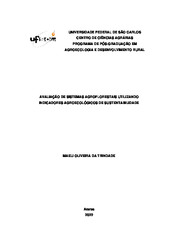Avaliação de sistemas agroflorestais utilizando indicadores agroecológicos de sustentabilidade
Resumen
Agroforestry Systems (SAFs) are recommended because they contribute
to an area returning to its initial landscape, given that they contribute to the
conservation of biodiversity and restore the provision of ecosystem services.
The objective of this study was to evaluate, through the application of a set of
ecological indicators of sustainability, if the agroforestry systems implemented
for restoration and agroecological production in the areas of Sitio São João,
promoted the return of the ecological functions of the local ecosystem. For this,
a protocol with ecological indicators was adapted and applied in two
Agroforestry Systems and an adjacent riparian forest, in order to relate to their
ecological functionality, which in turn is associated with the return and
maintenance of ecological processes provided by: species diversity, functional
diversity, development of individuals, system control and management and soil
protection and nutrient cycling, agrobiodiversity, socioeconomic aspects and
satisfaction. The two SAFs stood out positively in at least one ecological
functionality descriptor. The SAFs added an average of 37 points, that is, they
recovered on average the corresponding to 64.95% of the ecological
functionality in relation to the positive and referential scenarios, ranging
between 66.7% and 63.2%, for the SAFs 1 and 2. SAF1 showed better
functioning and one of the explanations is the characterization of each area,
where SAF1 was more biodiverse compared to SAF2. This can be explained by
the type of management I carry out in each area, as well as the choice of
species and the functions generated by them.
Colecciones
El ítem tiene asociados los siguientes ficheros de licencia:

